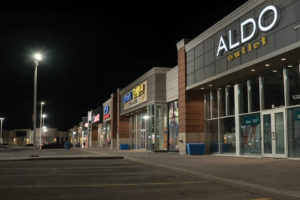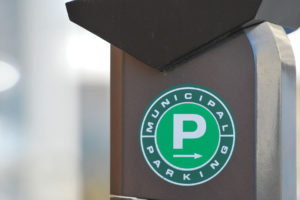By Jason Broadhurst
Anchored by notable retailers Loblaws, Home Depot and LCBO, College Square is a retail complex with forty-nine brand name stores, spanning 389,244 sq. ft. The shopping destination has been serving a busy area near Algonquin College, in Ottawa, Ontario since 2003.
When property managers Leikin Management Inc. moved forward on an exterior lighting upgrade, they had four very clearly defined objectives.
“Saving energy was the primary concern,” explained Barbara Farber, for Leikin Management. “We also wanted to reduce maintenance costs, improve the aesthetic quality of the complex, and make the area even safer after dark.”
The property management firm teamed up with Concept Illumination, a company known for its exterior and parking lot expertise, to plan and execute the renovation, which was subsequently completed over two phases. First, wall packs along the rear of each block of buildings were replaced with the latest LED products.
With several of the then existing wall pack lights burned out and daylight hours shortening in the middle of the Ottawa winter, Concept Illumination understood the urgency of replacing the lighting as quickly as possible. Despite battling freezing rain and snow, the install of the wall packs was done within a day, minimizing disruption to tenants and ensuring that the complex remained a safe place to visit.
With the LED wall packs being more directional than the predecessors, it was possible to get light on the building in the exact distribution pattern required to illuminate columns and doorways. The LED wall packs used are 0°-90° adjustable, and are fixed in this case at 15° to enable sufficient aesthetic light on columns and walls, while throwing enough light forward and away from the building to be functional for illuminating the immediate surrounding areas.
Combined with the control of the light distribution, the 4000K colour temperature resulted…
By Milirsan Pugalendiran, B.Eng. Civil Engineering, Lassonde School of Engineering – York University
Tom Arnold Scholarship in Parking Industry Advancement at York University 2018 Recipient
With the rise of mass-manufactured automobiles, a new industry was created. The parking industry was born with rise of affordable automobiles and has changed significantly since Henry Ford’s invention of the assembly line in 19081. The parking industry started off with simple parking lot designs and has now evolved to parking lots capable of self-parking. We now face even greater challenges with the rise of Autonomous vehicles which calls for “Smarter” parking lots. This article looks at how the Parking Industry has changed over the years and what the future holds for parking.
Past
The first automobile can be as early found in the late 1600’s but the parking industry began with the rise of the mass-produced vehicle, the “Model T”1. Something that was only for the wealthy had now become affordable for the average person.
People needed a space to park their cars, which prompted the creation of parking lots. With 23 million cars in America, parking became a serious issue and city officials turned to engineers to invent a solution which resulted in the first parking lots4.
At the beginning, parking lots were designed with diagonal bays to accommodate the fairly large automobiles and to allow for ease of parking2. Early automobiles were also not as weather resistant compared to the automobiles of today3 and so had to be designed with weather protection in mind. High-rise, fully enclosed parking garages were built to accommodate the larger volumes and to protect these vehicles from the elements. Innovations such as the “D’Humy ramp system”, which created split-level floors to maximize spaces, were incorporated into the high-rise buildings3.
Vehicles were parked by professional valets…
By Renee Smith
The Canadian Parking Association and its membership have always been supportive of students and young parking professionals trying to make their way into the industry. To remain strong, we must continue to support bright and inventive ideas by fostering the success and growth of emerging individuals—not just for those who want to join our industry. For those who want to redefine it.
Over the years, our industry has managed to keep up with the growing needs of our users. Our developments have had an extraordinary impact on the lives of Canadians and the communities where we live. New parking-planning approaches are improving the quality of life in our cities and promoting business development by giving us safer and more user-friendly parking facilities. Nowhere has the transformation of our industry been more apparent than in the growth of parking’s technology sector.
Today we take for granted technologies that yesterday seemed unimaginable. It wasn’t so long ago, for example, that most parkade transactions were made in cash and collected by cashiers at exit kiosks. Cars often piled up in exiting queues and theft was a nagging concern for parkade owners. Now, with tap payments becoming ubiquitous, most facilities have automated systems that can process credit cards. Exiting queues are not yet a thing of the past, but they are less frequent and shorter when they do occur.
Of course, it’s not just payment equipment that’s changing the face of the industry. Who could have foreseen mobile payment apps and parking guidance technology just a generation ago? The demand for tech-savvy parking infrastructure will only increase as advances in Smart Cities and smart-vehicles evolve. Inevitably, technology will dominate the industry for coming generations. We need to make sure that when self-driving vehicles are ready, parking technology, from advanced access…
By Chelsea Webster
First and foremost – what the heck is gamification? Great question. It’s the process of taking something that already exists (an app, or a website, for example), and integrating game mechanics to it, so that you end up with an augmented version that people are more motivated to use1. It’s not building a new game – it’s making whatever you’re already doing into a game.
To better understand the concept, consider a few common elements that almost every gamified system has: points, levels, achievements, a leaderboard, and rewards2. No matter what app or online games you’ve played, consider how these elements add up to pique your curiosity.
Let me give you a quick example. I’ve used a customer relationship management tool that utilizes gamification (https://crm.me/gamification/). As a new user, I log in and have a grand total of 0 points. As I click on different tabs and features, the system awards me points. There’s a progress bar for how many tutorials I’ve watched, so I plug away at that because I can see exactly how far I’ve come and what’s left to be done. It’s satisfying to get that kind of feedback. I build up my understanding of the application’s functionality and learn to update customer information and make notes in profiles. After I do this a couple of times, I earn enough points to move from level 1 to level 2. With that level up, I’ve unlocked a new task and can send email to customers, earning me a badge! A badge! Yes! What a great reward!
And imagine if the rewards that you get keep getting more appealing. It starts off with some trinkets or badges, moves up to earning power, access to locked content, and finally culminates in an elevated status in the game3. I’m not even…
By Chris Hylton
Earlier this year we sent out a survey to members of the Canadian Parking Association. The survey asked a variety of questions about issues to identify the emerging trends and help the industry respond.
Regarding data, we asked about how organizations were using data, real-time and projected, to drive parking policy and design. We also asked about the relationship between data and funding expansion projects.
Regarding technology, we asked about how organizations were implementing new technology and the success rate. This included things like parking and payment apps as well as charging stations.
Regarding customer experience, we asked about how technology and online relationships via social media channels have helped to improve the overall customer experience.
Data Use Trends
93% of respondents reported that they were seeing an increased use of data to drive their service and design. Just a few of the data points that organizations are tracking include: number of vehicles, fees, payment methods, type of vehicle (i.e.: gas, hybrid, electric), turnover, event usage, parking via permit, versus daily, or hourly paid.
Digital Technology Continues to Drive the Industry
Common technological trends mentioned by survey participants included the emergence and adoption of parking apps, mobile payment options, and the provision of charging stations for electric vehicles.
Over time parking apps have simply exploded. A few years ago, Calgary’s ParkPlus system which permitted payment by phone, was revolutionary. Now apps cover every conceivable aspect of our industry. From the customer perspective there are apps involved in guidance, payment, all in one, and even handsfree no touch apps.
As automakers rush to meet customer demands to turn vehicles into four wheeled smart phones, parking apps are hitting vehicle screens with increasingly sophisticated parking support.
Ford Motor Co. has developed FordPass, a vehicle system that can, among others, find and pay for…
Torontonians wanted an app for parking — and they got it
By Stacy Sneed
One of the fastest growing cities in North America, Toronto is a hub for the design, finance, science and media industries. The city is also known for its tech savviness and app usage. In 2016, the latest report by Yahoo Canada! shared that Canadian app use grew by an average rate of 74 percent, far exceeding the global average of 11 percent. In fact, the number of Canadian devices exceeds the estimated number of Canadians by more than 2 million. What this signifies is that people in Toronto enjoy the ease and convenience apps add to their lives. When citizens become accustomed to the advantages that apps provide, they want to have access in every part of their lives … including interactions with their local government.
As this growing metropolitan area reached over 6 million residents in 2014, it faced increased congestion and traffic. Finding parking in Toronto became a hassle for drivers, and parking payment options were limited. Drivers either had to have cash available for meters or use their credit cards at a pay station. The Toronto Parking Authority (TPA) realized that point of frustration for drivers, and saw an opportunity to offer a better way to pay for parking. TPA issued a request for proposal (RFP) for mobile pay providers in 2014 in an effort to improve the overall parking experience around the city.
“The choice to go with a mobile app was heavily driven by our customers. We also wanted to provide an operational cost savings with it,” said Ian Maher, TPA’s vice president of strategic planning and I.T.
TPA sought a solution to implement technology and make local trips faster and easier. In order to achieve that, the…









